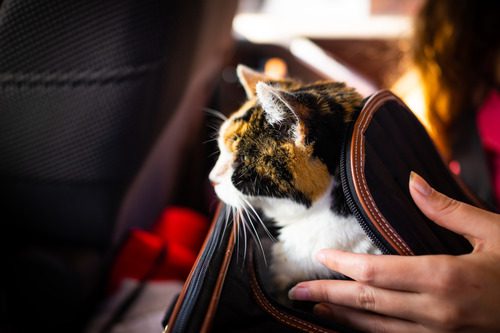Should You Sedate Your Cat for Travel?
Traveling with a cat can be a challenging experience, as many felines do not adapt well to changes in their environment. Some cats experience extreme anxiety when confined in a carrier, exposed to new surroundings, or subjected to the sounds and motion of travel. This stress can manifest in a variety of ways, from excessive vocalization to physical signs of distress such as panting, drooling, or vomiting. For pet owners, seeing their cat in distress can be upsetting and leave them wondering if sedation is the best solution to make the journey more manageable for their feline companion. While sedation can be beneficial in certain situations, it is not always necessary. Some cats may respond well to alternative calming methods, while others may require a tailored plan involving medication prescribed by your veterinarian.
In this blog, we will explore when sedation is appropriate, the different options available, alternative calming techniques, and essential travel tips to make the journey as smooth as possible for both you and your cat.

When Should You Consider Cat Sedation for Travel?
Not every cat requires sedation for travel. Some cats adapt well to car rides or flights, remaining calm and relaxed throughout the trip. However, for cats prone to travel anxiety, sedation may be necessary to prevent excessive stress. Signs that your cat may need sedation include:
- Excessive vocalization and distress – Meowing loudly or yowling for prolonged periods can indicate heightened anxiety.
- Panting or drooling – These physical signs are often indicators of extreme stress or nausea.
- Aggressive or frantic behavior in the carrier – A cat that attempts to escape, claws at the carrier, or displays aggression may be experiencing severe anxiety.
- Vomiting or signs of extreme anxiety – Some cats become so distressed that they may experience nausea and vomiting, making travel highly uncomfortable.
If your cat exhibits any of these behaviors, consulting with your veterinarian is crucial before deciding on sedation. Your vet will assess your cat’s overall health, temperament, and travel conditions to recommend the safest and most effective approach.
Types of Cat Sedation for Travel
When sedation is deemed necessary, pet owners have a few options to consider. The most suitable option will depend on the cat’s level of anxiety, the duration of travel, and any underlying medical conditions.
Prescription Sedatives and Anti-Anxiety Medications
Veterinarians often prescribe sedatives or anti-anxiety medications to help calm anxious cats during travel. These medications work by altering the brain’s chemical balance to reduce anxiety and promote relaxation. Common veterinary-prescribed sedatives include:
- Gabapentin – Frequently used for mild to moderate anxiety, gabapentin is a commonly prescribed medication that helps reduce stress and discomfort in cats. It has sedative properties but is generally well-tolerated.
- Trazodone – This medication is particularly effective for cats experiencing significant travel-related stress. It promotes a sense of calm and relaxation, reducing the risk of panic and aggression.
- Pregabalin – Similar to gabapentin, pregabalin is another medication that helps manage anxiety and stress in cats. It has sedative and pain-relieving properties and is sometimes used as an alternative for cats that do not respond well to gabapentin.
Both of these medications should only be administered under veterinary supervision, as dosages must be tailored to the individual cat’s weight, health status, and response to treatment. You should also conduct a trial run before the travel date to monitor how your cat reacts to the medication and to ensure there are no adverse effects.
Natural Alternatives to Sedation
If you prefer a more natural approach to calming your cat, there are several options to consider that may provide mild relaxation without the need for prescription medications:
- Pheromone sprays (e.g., Feliway) – These sprays mimic natural feline pheromones that signal safety and security, helping to reduce stress and anxiety.
- Herbal remedies (e.g., chamomile, valerian root) – Certain herbs have mild sedative effects that can help ease nervous tension in cats.
- CBD for cats – Cannabidiol (CBD) is gaining popularity as a calming supplement for pets, though it should always be used under veterinary guidance to ensure proper dosing and safety.
While these natural remedies can be effective for some cats, their success varies depending on the individual pet. A discussion with your veterinarian can help determine whether these options are suitable for your cat.
How to Travel with a Cat on a Plane
Check Airline Policies in Advance
Each airline has different rules and regulations regarding pet travel. Some airlines allow cats to travel in the cabin, while others may require them to be transported in cargo. To avoid last-minute surprises, research airline policies well in advance of your trip. Key aspects to check:
- Whether pets are allowed in the cabin
- Carrier size and weight restrictions
- Documentation requirements (health certificates, vaccination records)
- Pet fees and travel policies for emotional support or service animals
Choose an Airline-Approved Carrier
A well-ventilated, secure, and airline-approved carrier is essential for safe travel. Soft-sided carriers are often preferred for in-cabin travel as they fit more easily under airplane seats. When selecting a carrier:
- Ensure it is spacious enough for your cat to stand, turn around, and lie down comfortably.
- Choose a carrier with secure zippers to prevent escapes.
- Familiarize your cat with the carrier by leaving it open in your home for several days before travel.
Prepare Your Cat for Air Travel
To help your cat feel more at ease during air travel:
- Allow them to spend time in the carrier leading up to the trip.
- Use calming pheromone sprays inside the carrier.
- Limit food intake before the flight to reduce nausea and discomfort.
Consider Sedation or Alternatives
Speak with your vet about mild anti-anxiety medication if necessary. We do not recommend sedation when traveling in cargo, as sedatives can affect a cat’s ability to regulate body temperature and respond to stress.
Airport and Security Tips
Carry necessary health documentation as required by the airline. Prepare for TSA screening by securing your cat with a leash or harness in case they need to be removed from the carrier. In addition, avoid opening the carrier in unsecured areas to prevent escape.
How to Travel with a Cat During Long-Distance Car Rides
Choose the Right Carrier
A high-quality, well-ventilated carrier provides safety and comfort for car travel. Ensure it has enough room for your cat to move, stretch, and lie down comfortably.
Make the Carrier a Safe Space
You can try placing a soft blanket or bedding that smells like home inside the carrier. Add familiar-smelling items, such as an unwashed t-shirt or a favorite toy. Use pheromone sprays to create a calming atmosphere.
Plan for Breaks and Hydration
Plan to stop every 2-3 hours during your ride to check on your cat. Offer water at regular intervals to ensure your pet is properly hydrated. Avoid feeding right before or during travel to prevent nausea.
Minimize Stress During the Drive
Maintain an agreeable temperature inside the car so you and your cat can remain comfy. Try playing soothing music or white noise to help keep your cat calm. Do not suddenly brake or make sharp turns.
Safety Considerations
We recommend always testing sedatives well before your trip to monitor your pet for side effects. Do not administer human medications without veterinary approval. Be sure to keep your cat secured in the carrier at all times to prevent escape or injury.
Helping Your Cat Have a Stress-Free Trip
Every cat reacts differently to travel, and their needs will vary. While some may require sedation, others may do well with natural calming methods. Consulting with your veterinarian will help determine the best travel approach for your cat’s unique situation. If you’re planning a trip and need expert advice on cat sedation for travel, contact Lane Veterinary in Hinsdale, IL, at (630) 320-6644 or book an appointment online today.
Recent Posts
About Us
Choosing a vet means entrusting your pet’s care and well-being to capable hands. Lane Veterinary strives to be a lifetime vet for you and your family, being the people you can always lean on for support and guidance. As a privately owned practice, we stand to give people and their pets the one-on-one care and attention they deserve in a calm and comfortable setting.
